NSW teachers have taken strike action for the third time in six months.
About 20,000 teachers marched on NSW parliament during a combined state-wide strike of public school and Catholic school teachers on 30 June—the first time in 26 years both unions have struck together.
It was a taste of the kind of action needed across the public sector to force NSW Liberal Premier Dominic Perrottet to act on the workloads and staffing crisis.
The strike saw 550 schools completely shut across the state with another 1000 seriously disrupted, according to the Education Department.
Chanting “scrap the cap”, teachers called on Perrottet to end the pay cap of just 3 per cent a year, with inflation already at 5.1 per cent and climbing further.
Pay and conditions at public schools set the pace for those in the Catholic school system.
As the Independent Education Union’s Mark Northam explained, “That salary cap, even though it’s not applicable in a strict legal sense to our union … captures us as well. In the negotiating room we have our hands shackled behind our back.”
The IEU is demanding a 10 to 15 per cent pay rise over two years and the same pay for support staff as they receive in the government system.
The problems teachers face in the Catholic system also mirror those in public schools.
As Christine Wilkinson, who teaches at St. Joseph’s Catholic College in Gosford, explained, “Teachers are broken and drowning in a sea of ever-increasing workloads—administrative tasks, including data collection, new computer systems, teacher accreditation demands, reporting and marking.
“The casual teacher shortage is placing enormous pressure and stress on teachers who are being asked to take extra lessons on a daily basis, and to babysit students in overcrowded classrooms.”
Teachers Federation president Angelo Gavrielatos told the crowd that “new shocking figures tabled in parliament” showed the scale of the merged classes and minimal supervision when there was no teacher to take a class over the past 18 months.
“Hundreds of classes are combined every day. Thousands of students denied their learning.
“This year alone Mudgee High School … has only provided minimal supervision or merged classes 2000 times,” he said. And while the crisis is worst in regional areas, “this is not an issue of the central west or the far west”, Gavrielatos explained, with problems even across inner Sydney.
He reinforced that “the teacher shortage cannot be fixed without fixing the salaries and the workload problem”.
Electing Labor
But instead of escalating the strike action, the union is focused on getting a Labor government elected at the state election.
“If there is no agreement we will keep campaigning until next March, election day 2023,” Gavrielatos said.
This was repeated at the Teachers Federation’s annual conference a few days after the strike.
The major session on salaries and conditions passed an official recommendation for “a state election campaign plan” to include “media and advertising strategies … to ensure there is broad community understanding about what is at stake at the next election”.
While Gavrielatos told the conference that after taking strike action three times the union was prepared to “do it again and again”, there was no discussion of when that might happen. The recommendation talked only vaguely about the need to “continue to explore, develop and implement the full range of industrial, political and media strategies”.
Perrottet and the NSW Liberals need to go. But the best way to get the Liberals out is to build a united industrial campaign. Folding the campaign into a marginal seats campaign or door-knocking for the state election will do nothing to build the union power that can win real pay rises and force the government to fund services.
The train drivers’ industrial campaign has now forced the government to finally back down on safety and staffing concerns on the new intercity fleet. Nurses are also preparing for further action over pay and nurse-to-patient ratios. Public servants took strike action in June.
With all the major public sector unions in NSW campaigning against the state Liberal government, now is the time to step up the industrial campaign.
The next step should be setting a date for a teachers’ and public sector-wide strike and stopwork rally in early August.
NSW Labor leader Chris Minns has said nothing about supporting above-inflation wage rises or cutting teachers’ workloads. He has called on the rail workers to end their industrial action. In May, he refused to support the nurses’ demand for enforceable nurse-to-patient ratios.
The situation in public education is unsustainable and there is widespread community support for the teachers’ campaign. Electing a Labor government in nine months is not going to fix the problems.
Teachers and public sector workers need to organise for a united public sector-wide stopwork rally to win action on workloads and a real, above-inflation pay increase.
By James Supple






